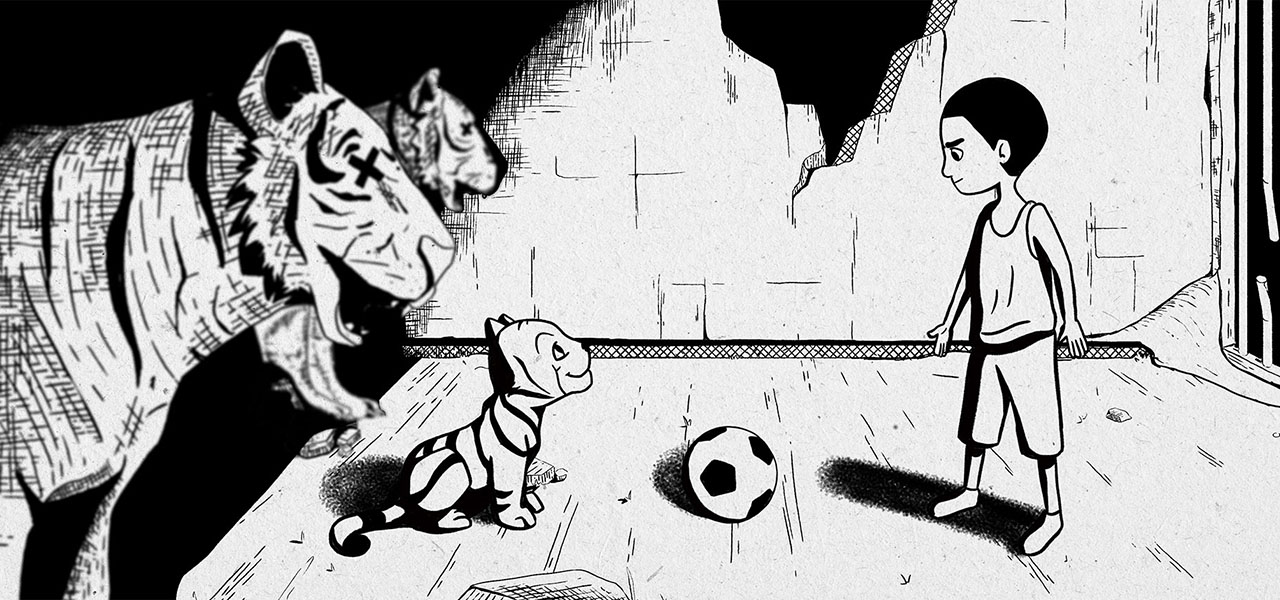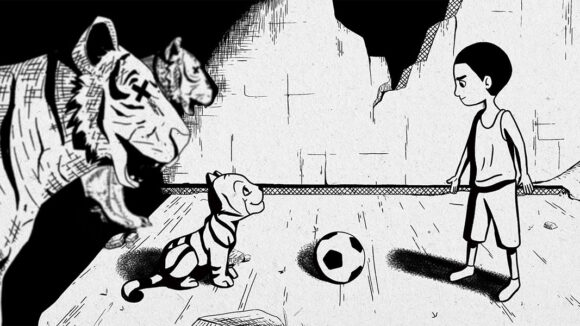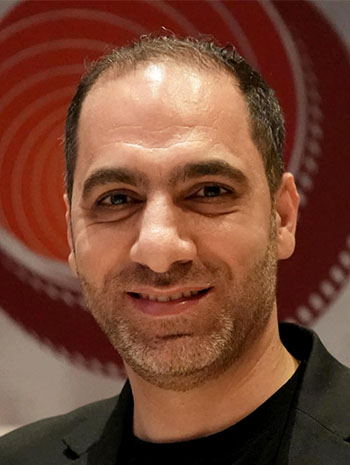

2025 Oscars Short Film Contenders: ‘Zoo’ Director Tariq Rimawi
Cartoon Brew is putting the spotlight on animated short films that have qualified for the 2025 Oscars.
In this installment, we’re looking at Zoo from Jordanian filmmaker Tariq Rimawi. The short earned its Oscars qualification through theatrical exhibition.
Based on true events, Zoo was inspired by the world’s worst zoo located in Gaza, in which dead animals were exhibited. As a young boy travels through a war-torn city in order to find a place to play football, he stumbles upon the infamous zoo and encounters a little tiger cub who joins him on his quest. But the remnants of war harbor many dangers. The film is produced by Berlin-based Nice Creative.
Cartoon Brew: Black and white particularly suits this story full of shadows and stark contrast between light and darkness. How did you settle for this choice, having started exploring color in the original concepts?

Tariq Rimawi: We initially explored using color in the concept art to add to the characters and environment. However, as the story developed, it became clear that black and white was a better fit for the film’s tone and message. The strong contrast between light and darkness in black and white perfectly reflects the themes of the story — hope amidst despair, resilience in the face of adversity, and the sharp divide between life and loss. It also emphasizes the double standards in the real-life events that inspired the film, highlighting the care given to the animals while the people of Gaza continue to face hardship. The shadows and textures of the black-and-white style allowed us to create a raw, emotional atmosphere by stripping the visuals down to their essence. This approach enabled us to focus on the emotional weight of the story without the distraction of color.
What was it about this story or concept that connected with you and compelled you to direct the film?
In 2016, I came across a headline about rescuing Laziz the tiger and fifteen other animals from the “World’s Worst Zoo” in Gaza. At that moment, I knew this story would become the foundation of my next animated film. The zoo was a tragic symbol of the devastating effects of war. Many animals had died due to disease, hunger, and stress, and their dead bodies were mummified and displayed in their cages. Among the survivors was Laziz, a tiger who, along with the other remaining animals, was rescued and relocated to safe reserves outside Gaza by an international animal welfare organization. However, while the animals found refuge, the harsh reality for the people of Gaza remained unchanged. Through our animated film, we aim to shed light on this powerful narrative — not only to document Laziz’s journey but also to spark conversations about the human and environmental toll of conflict. It’s a story that goes beyond borders, emphasizing the universal need for empathy, solidarity, and the pursuit of a better future for all.
What did you learn through the experience of making this film, either production-wise, filmmaking-wise, creatively, or about the subject matter?
We realized the value of research and preparation. Telling a story based on real events while abstracting the politics and focusing on the human side required us to carefully balance authenticity and respect for both local and international audiences. This project challenged us to think deeply about visual storytelling. We wanted the audience to feel the emotional weight of the boy Sami and the tiger’s journey and the struggles of a war-torn area without using dialogue. It was challenging but rewarding to convey themes like loss, resilience, and hope through imagery, black-and-white tones, and character movement.
This passion and belief for telling meaningful stories led us to receive support from the Royal Film Commission in Jordan and from the Robert Bosch Stiftung in Germany. As a Jordanian animation director and writer, it was particularly important to trust local talents, most of whom are recent university graduates. They contributed to various aspects of the film, including concept art by creative producer Aminah Abdat, storyboarding, and character design by Farah Varouqa, and environment design by Mai Kilani. The 2d and 3d animation was brought to life by Salsabeel Abuobaid and Tulip Swedat, while sound was designed by Mohammed Shafagoj. Their deep understanding of the culture and values of the story enriched the film and supported the growth of the industry in Jordan.
At the same time, collaborating with international talents, such as the German creative producer Moritz Mayerhofer, added a different perspective to the making of the film and allowed us to benefit from his valuable experience in the animation industry. The music, composed by Peter Thomas Gromer, also added depth to the film. This collaboration facilitated a valuable exchange of ideas and expertise, enhancing creativity and ensuring a richer, more impactful film.
Can you describe how you developed your visual approach to the film, why you settled on this style/technique, and how this shaped the final work?
The black-and-white hatchings in Zoo are inspired by the work of Palestinian cartoonist Naji al-Ali, whose style has influenced my work over the years. This simple yet powerful style reflects the double standards of the real-life story that inspired the film. The contrast between black and white highlights the difference between the care given to the animals and the ongoing struggles of the people in Gaza. By removing color, the focus remains on the emotions of the story. The textured lines add depth and a sense of unease, emphasizing the themes of loss, resilience, and the unfairness of the situation. We also explored the balance between realism and abstraction, using stylistic choices to represent both the harsh reality of the zoo and the imaginative world of the characters. This style makes the film’s message clear and accessible to everyone, regardless of age or language. The absence of dialogue, combined with the bold visuals and emotional music, helps Zoo connect deeply with audiences around the world.
